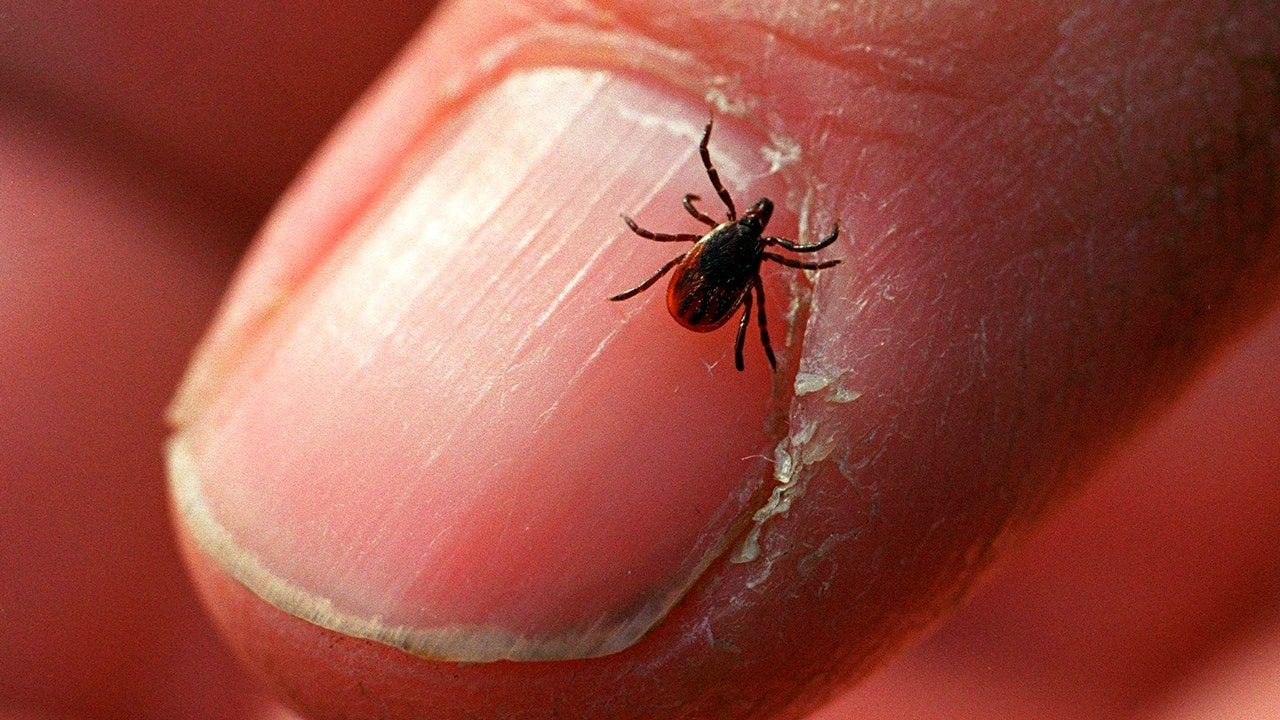Health
SIDS linked to brain abnormality that increases babies’ risk in ‘unsafe sleep conditions,’ study finds

About 3,400 babies die of sudden infant death syndrome (SIDS) each year in the U.S., according to the Centers for Disease Control and Prevention (CDC).
Now, a new study led by researchers at Boston Children’s Hospital and Harvard Medical School suggests that some of the unexplained deaths may be caused by an abnormality in the medulla, which connects the brain stem and the spinal cord.
The study was published in the Journal of Neuropathology & Experimental Neurology on May 25.
SURGEON GENERAL’S ADVISORY ON SOCIAL MEDIA AND YOUTH MENTAL HEALTH COMES AMID ‘REAL-TIME EXPERIMENT’
“We found abnormalities in a particular receptor (the serotonin receptor 2A/C) in the medulla oblongata, part of the lower brain stem that regulates autonomic and respiratory function, in a subset of SIDS infants,” lead author Dr. Robin Haynes, PhD, who is a principal associate at Harvard Medical School, told Fox News Digital via email.
A new study suggests that some of the unexplained deaths may be caused by an abnormality in the medulla, which connects the brain stem and the spinal cord. (iStock)
When a baby isn’t getting enough oxygen, the serotonin receptor 2A/C triggers the baby’s natural instinct to gasp for air, the doctor explained.
When the receptor has an abnormality that doesn’t allow it to function correctly, it doesn’t send the signal to the baby to “reoxygenate the brain.”
“This places them at greater risk in unsafe sleep conditions, such as prone sleep and bedsharing, when the levels of oxygen around the infant’s airway may be lower than normal,” Haynes said.
BE WELL: PREVENT DROWNING WITH THESE CHILD WATER SAFETY TIPS
The researchers analyzed brain tissue from 70 infants who died. All 58 of the babies who died from SIDS were shown to have the altered serotonin receptor 2A/C.
Previous studies also linked abnormalities in the brain and nervous system to a higher risk of SIDS, Haynes said.
Older SIDS infants showed more of these abnormalities than younger infants, which surprised the researchers.

While it’s recommended that babies sleep in the same room as parents or caregivers, they should not share the same bed, says the American Academy of Pediatrics. (iStock)
“This suggests the possibility that there are different pathological mechanisms in younger versus older SIDS infants,” said Haynes.
“More research is necessary to better understand these mechanisms and how they relate or interact with the specific environmental risk factors that infants may face.”
‘No way to identify risk’
While the study sheds light on one potential cause of SIDS, there is currently “no way to identify an infant at risk for SIDS,” Haynes said — as babies who die of SIDS appear healthy up until the unexplained death.
“Abnormalities in this neurotransmitter system are undetectable in a living infant,” she said. “Because of this, it is critical at all times to follow safe sleep practices.”
“It is critical at all times to follow safe sleep practices.”
Dr. Chandani DeZure, a board-certified pediatrician in Palo Alto, California, who is also a member of the BabyCenter Medical Advisory Board, was not involved in the study but shared her opinion of the findings.
“Research shows that inadequate levels of serotonin found in the brain stem of 70% of babies who passed away from SIDS may make an infant more vulnerable,” DeZure told Fox News Digital.
Serotonin is important during sleep as it affects heart rate, breathing and blood pressure, the doctor explained.

There has been a trend of disproportionately high cases of SIDS in Black and Native American/Alaskan Native families, a doctor told Fox News Digital. (iStock)
“While this study adds to the growing body of evidence about the potential role of serotonin in SIDS, we still don’t know how to identify babies who may have an underlying vulnerability,” she added.
Some factors do put babies into a higher risk category, however.
A SIDS diagnosis is made only when no other cause of death is identified after a full investigation.
Babies between 2 and 4 months old are most likely to experience SIDS, with 90% of cases occurring in infants under 6 months old, DeZure noted.
KIDS AS YOUNG AS 4 YEARS OLD CAN BEGIN TO LEARN MEDICAL EMERGENCY TRAINING: NEW REPORT
“Further, babies born prematurely, babies with a family member who died of SIDS, those who have smoke and alcohol exposure in the womb and/or home, and children with underlying physical vulnerabilities (such as certain heart conditions or breathing issues) are high at-risk groups,” she went on.
There has been a trend of disproportionately high cases of SIDS in Black and Native American/Alaskan Native families, DeZure said.
“It’s important that research help address these health disparities in marginalized communities,” she said.
Safe sleep habits key to prevention
A SIDS diagnosis is made only when no other cause of death is identified after a full investigation, according to the Cedars Sinai website.
Although studies like this one point to possible causes of SIDS cases — including brain abnormalities, respiratory illness and heart function — there is no way to predict which babies might be more susceptible, experts say.

Babies should be put to sleep on their backs on a firm, flat surface at naptime and bedtime — with no pillows, loose bedding or other objects that could interfere with breathing, according to the AAP’s guidelines. (iStock)
“Until we have more research, the best things for parents to do is try to minimize the risk of SIDS by using proven methods like safe sleep habits and breastfeeding (if possible), especially during the first few months of life, when newborns are the most vulnerable of dying from SIDS,” said DeZure.
The American Academy of Pediatrics (AAP) launched its Back to Sleep campaign in the early 1990s; that program has since been renamed Safe to Sleep.
The AAP’s guidelines call for putting babies to sleep on their backs on a firm, flat surface at naptime and bedtime, with no pillows, loose bedding or other objects that could interfere with breathing.
CLICK HERE TO SIGN UP FOR OUR HEALTH NEWSLETTER
While it’s recommended that babies sleep in the same room as parents or caregivers, they should not share the same bed, the AAP says.
Breastfeeding, giving babies pacifiers and having daily “tummy time” sessions have all been shown to lessen the risk of SIDS.

Using home baby monitors shouldn’t be regarded as a means of preventing SIDS, the AAP states. (iStock)
Using home baby monitors shouldn’t be regarded as a means of preventing SIDS, the AAP states.
“There is no data to suggest this works and, if anything, it can cause harm by increasing parental anxiety or giving false reassurance,” DeZure said.
Since the AAP’s campaign launched, SIDS cases have been reduced by nearly half, the doctor said.
“However, after 2001, SIDS cases in the U.S. remain the leading cause of death for infants under 1 year old, so there is a vital role for research that can help find additional ways to reduce the risk of SIDS,” she added.
If parents have questions about how to prevent SIDS, they should speak to their baby’s pediatrician or primary care physician for more information, said DeZure.

Health
fatty15 has the essential nutrient to ease stress and well-being

Sign Up
Create a free account to access exclusive content, play games, solve puzzles, test your pop-culture knowledge and receive special offers.
Already have an account? Login
Forgot your password?
Get back to the Sign In
Use left and right arrow keys to navigate between menu items.
Use escape to exit the menu.
Health
Summer is tick season, but these tips can help you avoid the bloodsucking bugs

Tick season is starting across the U.S., and experts are warning the bloodsuckers may be as plentiful as ever.
Another mild winter and other favorable factors likely means the 2024 tick population will be equal to last year or larger, some researchers say.
“It’s very bad and has only been getting worse,” said Susanna Visser of the Centers for Disease Control and Prevention.
TICK BITES AND LYME DISEASE: WHAT TO DO IF A TICK BITES YOU OR YOUR PET
An increasing variety of ticks are pushing into new geographical areas, bringing unusual diseases. Exotic southern species like the Gulf Coast tick and the lone star tick are being detected in New York and other northern states, for example.
But the tick that experts warn of the most is a common blacklegged tick, which is found mainly in forests and spreads Lyme disease. Infection rates begin to peak in May, and U.S. health officials estimate nearly half a million Lyme disease infections happen annually.
Here’s a look at what’s expected this year and how you can protect yourself.
An adult deer tick, also known as the blacklegged tick, crawls on a fingernail at Connetquot State Park in Oakdale, New York on Dec. 27, 2011. (Bill Davis/Newsday RM via Getty Images)
TICK FACTS
Ticks are small, eight-legged bloodsucking parasites — arachnids, not insects — that feed on animals and sometimes people. Some ticks are infected with germs that can cause illness, and they spread those germs when they bite.
There is no widely accepted estimate of how many ticks there are from one year to the next, but there is a scientific consensus that they are an increasingly common health hazard in large portions of the United States.
Blacklegged ticks — also known as deer ticks, since they feed on deer — are among the most common ticks in the eastern half of the U.S. They were plentiful centuries ago, then diminished when forests were cut down and deer were hunted, and rebounded alongside deer and wooded suburbs. The ticks have spread out from pockets in New England and the Midwest over a wider range.
Tick populations cycle throughout the year and their numbers depend on a few factors. They like warm, humid weather, and more can be seen after a mild winter. The more deer and mice available to feed matters, too.
Overall, the blacklegged tick population has been expanding for at least four decades, researchers say.
“This is an epidemic in slow motion,” said Rebecca Eisen, a CDC research biologist and tick expert.
2024 TICK SEASON FORECAST
Weather can play a role in the severity of a tick season.
Very cold, dry winters can whittle down tick populations, but recent winters have been mild — a trend some attribute to climate change.
As Scott Williams, a tick researcher at the Connecticut Agricultural Experiment Station, said: “Winters are no longer limiting the tick population.”
Ticks can withstand the heat but tend to almost hibernate when it’s a dry summer. That happened in Maine in 2020 through 2022, said Chuck Lubelczyk, a vector ecologist at the MaineHealth Institute for Research.
But last year was a very wet year, and tick activity multiplied in Maine — the state with the highest incidence of Lyme disease in the country. Weather service predictions call for higher temperatures and precipitation, so “on paper, at least, it could be a very good year for the ticks,” Lubelczyk said.
In Wisconsin, adult ticks were out longer than usual due to a mild winter. The tick nymphs are starting to emerge, and a wet spring is setting the stage for the possibility that the population will be robust, said Xia Lee, an entomologist at the Wisconsin Department of Health Services.
Ditto New York.
“It will be as bad as last year, or worse,” said Saravanan Thangamani, who studies ticks and tickborne diseases at SUNY Upstate Medical University in Syracuse.
WHAT IS LYME DISEASE?
Not all ticks are infected with disease-causing germs — about 20% to 30% of the blacklegged tick nymphs that emerge in the Northeast and Midwest this spring and into summer will be carrying the bacteria that causes Lyme disease, experts estimate.
Lyme disease symptoms tend to start between three and 30 days after a bite occurs and can include fever, headache, fatigue and a bull’s-eye-like rash. If you get bitten and develop symptoms, see a doctor to get treated with antibiotics.
HOW TO KEEP TICKS OFF OF YOU
Experts say the best thing to do is take steps to avoid a tick bite in the first place.
If you go outdoors, make note of wooded areas and where grassy properties start bleeding into wooded areas. Ticks tend to perch on ankle-level vegetation with their upper legs outstretched, waiting to latch on to an unsuspecting dog or human.
Try to walk in the middle of paths, wear light-colored and permethrin-treated clothing and use Environmental Protection Agency (EPA)-registered insect repellents.
HOW TO CHECK FOR TICKS
When you come inside, check for ticks. They can be found anywhere on the human body, but common spots include around the waist, behind the knees, between fingers and toes, on underarms, in the belly button and around the neck or hairline.
They are harder to see when they are young, so look carefully and immediately pull them off with tweezers.
The CDC does not recommend sending individual ticks to testing services for analysis, because a person might get more than one tick bite and the results from the tested tick may not be sufficient information.
Health
Pizza for Weight Loss? Top MD Says This Dough Makes It Possible

Sign Up
Create a free account to access exclusive content, play games, solve puzzles, test your pop-culture knowledge and receive special offers.
Already have an account? Login
Forgot your password?
Get back to the Sign In
Use left and right arrow keys to navigate between menu items.
Use escape to exit the menu.
-

 World1 week ago
World1 week agoPentagon chief confirms US pause on weapons shipment to Israel
-

 Politics1 week ago
Politics1 week agoRFK Jr said a worm ate part of his brain and died in his head
-

 World1 week ago
World1 week agoConvicted MEP's expense claims must be published: EU court
-

 News1 week ago
News1 week agoStudents and civil rights groups blast police response to campus protests
-

 Politics1 week ago
Politics1 week agoCalifornia Gov Gavin Newsom roasted over video promoting state's ‘record’ tourism: ‘Smoke and mirrors’
-

 Politics1 week ago
Politics1 week agoOhio AG defends letter warning 'woke' masked anti-Israel protesters they face prison time: 'We have a society'
-

 News1 week ago
News1 week agoNine Things We Learned From TikTok’s Lawsuit Against The US Government
-

 Politics1 week ago
Politics1 week agoBiden’s decision to pull Israel weapons shipment kept quiet until after Holocaust remembrance address: report















